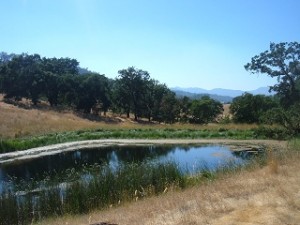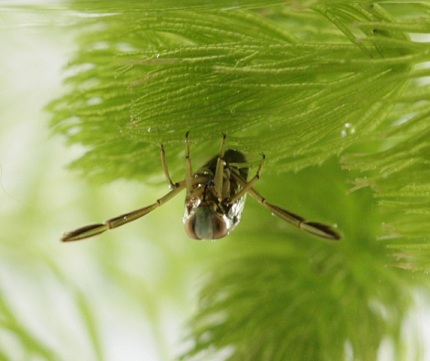Life history trade-offs in the context of environmental stressors
Animals confront a wide array of stressors in their environment including natural (e.g. predation, cannibalism, food limitation, and abiotic stresses) and anthropogenic stressors (e.g. habitat degradation, pollutants, climate change). These stressors can alter the landscape of life-history trade-offs, reshaping both what is an adaptive allocation of resources to different functions and the capacity of organisms to make adaptive allocations. Dr. Rosalind Murray, a former postdoc in the McCauley and Rowe labs, has been leading this research. Dr. Murray came into the lab with a deep background in evolutionary ecology and has built on this to bridge the worlds of eco-immunology, life history evolution, and aquatic ecology. Utilizing a powerful combination of field sampling and experiments, she has been investigating how natural stressors such as the presence of potentially cannibalistic conspecifics affect the capacity of animals to mount an immune response (Murray et al., Ecological Entomology 2019). She found that dragonfly larvae exposed to conspecifics increase their immune response to a simulated parasite. This finding brings into question some fundamental assumptions about how population density affects the spread of pathogens. While density increases the potential for contact between pathogens and hosts, if the presence of conspecifics induces an upregulation of the immune response, animals living in higher densities may be less vulnerable to infection. These results provide novel insights into why infection rates often do not track density as strongly as expected. Future work in this area can provide a better understanding of how an important aspect of ecological context, density and consumption risk, affect disease dynamics.
As faculty at UTM Ros Murray has expanded her research to examine more broadly how ecological context alters multiple aspects of an animal’s life history. Using a grant she obtained from the Centre for Urban Environments, Ros examined how exposure to road salt (a common contaminant of aquatic environments in urban and suburban regions) shapes patterns of growth and immunity in larval dragonflies (Mangahas, Murray, and McCauley 2019) as well as how these conditions can alter adult size, morphology, immunity and their phenology of emergence. The consequences of salinization in aquatic systems have been explored primarily from the perspective of its effects on mortality and subsequent alterations in community structure, however, the sub-lethal effects of road salt contamination on those organisms that do persist in these environments are underexplored. This represents a critical gap in our understanding of the effects of this common pollutant on the functioning of these systems and has implications for everything from the conservation of species remaining in these sites to the functioning of the ecosystems.
A master’s student in Biomedical Communication, Brittany Cheung, used this research and featured some of research done by Ros Murray and Racquelle Mangahas in a video on how contamination by road salts can affect aquatic ecosystems. Brittany did an incredible job and I think the video provides both education and advocacy for why we should reduce the use of road salts.
Effects of warming on dispersal and connectivity
Climate change affects organisms in multiple ways, changing the distribution of suitable environments, shifting the timing of life-history activities, and affecting the conditions in which these organisms develop. Relatively little work, however, has explored the potential for interactions between these processes. Myself and collaborators Karen Mabry and John Hammond are looking at one potentially critical interaction between these responses, the influence of developmental temperatures on body size and the consequent effects on dispersal. Dispersal allows organisms to track changing environmental conditions may help populations and species avoid extinction. However, our growing understanding of dispersal biology indicates that most dispersal is phenotype-dependent and that body size is a critical factor in determining the ability and propensity of organisms to disperse. Body size decreases in response to climate warming may indirectly impact the ability of organisms to disperse and shift their ranges to follow the distribution of suitable habitat, most often negative ly (McCauley & Mabry 2011). We are examining the linkage between developmental temperature and dispersal behavior experimentally in dragonflies. By experimentally manipulating the water temperatures they experience during development, we can determine the effect of these temperatures on body size, morphology, and ultimately dispersal behavior. This work is being conducted at the Quail Ridge Reserve, part of the UC’s Natural Reserve System with additional work occurring at the Wantrup Wildlife Sanctuary in the Pope Valley.
ly (McCauley & Mabry 2011). We are examining the linkage between developmental temperature and dispersal behavior experimentally in dragonflies. By experimentally manipulating the water temperatures they experience during development, we can determine the effect of these temperatures on body size, morphology, and ultimately dispersal behavior. This work is being conducted at the Quail Ridge Reserve, part of the UC’s Natural Reserve System with additional work occurring at the Wantrup Wildlife Sanctuary in the Pope Valley.
Phenotype and context dependent dispersal
I am continuing research on how phenotype-dependent dispersal can influence habitat connectivity and the composition of local populations (McCauley et al. 2010; McCauley 2010), and on the mechanisms that shape traits related to dispersal (Benard & McCauley 2008). Recent work in this area includes an examination of how dispersal success can be influenced by interactions between individual traits that affect dispersal capacity and conditions in the matrix habitat. This project was conducted in collaboration with Marie-Josée Fortin and Locke Rowe. Work on how phenotype dependent dispersal affects interactions within communities across a gradient of spatial isolation and contributes to realized connectivity will continue in both the dragonfly system and in other aquatic taxa. I am also interested in context-dependent dispersal, such as predator-induced dispersal (McCauley & Rowe 2010), can shape connectivity across landscapes.
Metacommunity ecology of the pools and ponds of the islands of the Georgian Bay
In 2011 a grant from the National Geographic Committee for Research and Exploration allowed myself and Marie-Josée Fortin (U of T, St. George) as well as graduate student Aaron Hall to initiate a survey of the aquatic habitats nested within the islands of the Georgian Bay Islands National Park. This work was assisted by undergraduate researchers from Cal Poly. We investigated patterns of community structure in the water-bodies on these islands which form the world’s largest freshwater archipelago. These habitats offer a unique opportunity to use the naturally patchy and nested structure of ponds situated on islands to determine the relative contributions of processes at local and regional scale to community structure.

